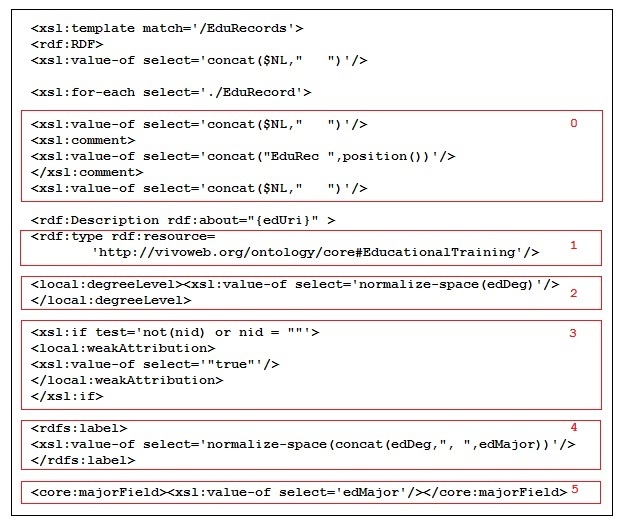...
At this point we have everything needed to generate the RDF for each EduRecord . We will create RDF/XML that describes each as an instance of the class vivo:EducationalTraining . This object is identified by a URI as are the educational institution conferring the degree and the recipient. Each instance is further enriched by other data properties. The special local:weakAttribution predicate is used when the recipient has no netid. The full transform can be found in mkEduRDF.xsl , the main parts are shown in the next two figures.
mkEduRDF.xsl Fragment 1 - Figure 15a
- [F15H0] Pretty printing that produces nicely formatted output.
- [F15H1] Declare the type of each instance.
- [F15H2] Using a local:degreeLevel predicate, assert the degree level.
- [F15H3] Assert a weak attribution when the EduRecord has no netid.
- [F15H4] Assert a label for each instance.
- [F15H5] Declare the major field of study.
mkEduRDF.xsl Fragment 2 - Figure 15b
...
Create RDF for New Persons and Organizations
This part of the process is needed to provide RDF that describes the new people and organizations discovered in earlier steps. The transforms are mkAccPeopleRdf.xsl and mkAccOrgRdf.xsl . These transforms are fairly simple and are applied to the NewPers.xml and NewOrgs.xml respectively. The output of these transformations can be found in example/rdf in the files NewPers.rdf and NewOrgs.rdf . These RDF files must be asserted using the VIVO user interface so that the data model of of Figure 2 can be traversed and so that when Per0.xml and Org0.xml are reconstructed for the next round of ingest the new people and organizations names together with their URIs are available for matching and assignment. Otherwise duplicates with different URIs are likely to be created.
Add Predicates and RDF to VIVO
...



